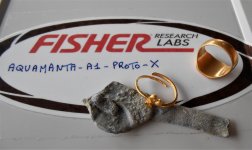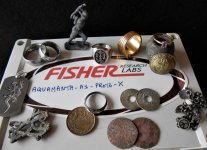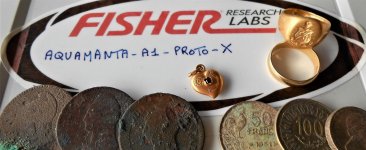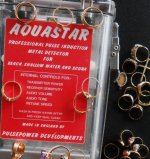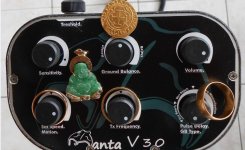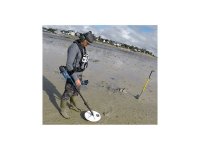LE.JAG
Jr. Member
- Oct 31, 2013
- 78
- 154
- Detector(s) used
- FISHER AQUAMANTA / Pulsepower Goldscan 5c - goldquest ssv3 / Vista Gold / Nexus
- Primary Interest:
- All Treasure Hunting
Hi,
I am back
some news from the next Fisher Aquamanta
for those who have not followed the story
Alexandre who has developed manta technology
MANTA METAL DETECTORS | PULSE INDUCTION HIGH SENSITIVITY
was bought back and hired by the Fisher First Texas group
are on the program
at first the Fisher Aquamanta
a pulse with extraordinary sensitivity to gold
calibrate to 7us // 16 volts
and able to cut iron under certain conditions
he can take an alliance 18k of 1/3 gr under iron nails
and above all he is able to cross the volcanic sand to take the gold
a video that dates a little / but shows the possibility of the machine
which has evolved a lot since
in French
it will be followed by a special Terramanta nugget
then / two others using Bipolar technology
which consists of alternating positive and negative pulses
easy to say on paper / but nobody had ever succeeded before Alexandre ...
the positive pulse magnetizes the ground and lightning the target
the negative pulse demagnetizes the ground = and removes the effect of ground !!!
and much more is planned later
I test the latest Aquamanta Fisher electronic map
and I've never had anything so deep and sensitive about gold
not : the box on the video and the photos
just there / to test the cards
the final product will have a modern / lightweight design and well balance...
pre-series launch / if all goes well /
in the next three months
better than all my pulsepowers
and I owned 9 ....
some finds on my last tides
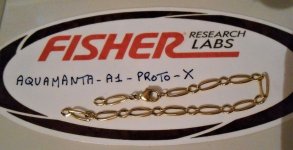
I am back

some news from the next Fisher Aquamanta
for those who have not followed the story
Alexandre who has developed manta technology
MANTA METAL DETECTORS | PULSE INDUCTION HIGH SENSITIVITY
was bought back and hired by the Fisher First Texas group
are on the program
at first the Fisher Aquamanta
a pulse with extraordinary sensitivity to gold
calibrate to 7us // 16 volts
and able to cut iron under certain conditions
he can take an alliance 18k of 1/3 gr under iron nails
and above all he is able to cross the volcanic sand to take the gold
a video that dates a little / but shows the possibility of the machine
which has evolved a lot since
in French

it will be followed by a special Terramanta nugget
then / two others using Bipolar technology
which consists of alternating positive and negative pulses
easy to say on paper / but nobody had ever succeeded before Alexandre ...
the positive pulse magnetizes the ground and lightning the target
the negative pulse demagnetizes the ground = and removes the effect of ground !!!
and much more is planned later
I test the latest Aquamanta Fisher electronic map
and I've never had anything so deep and sensitive about gold
not : the box on the video and the photos
just there / to test the cards
the final product will have a modern / lightweight design and well balance...
pre-series launch / if all goes well /
in the next three months
better than all my pulsepowers
and I owned 9 ....
some finds on my last tides

Attachments
Upvote
0


